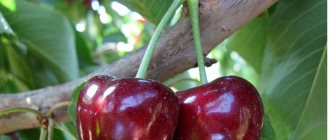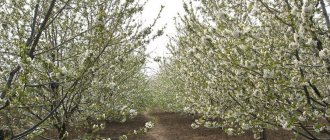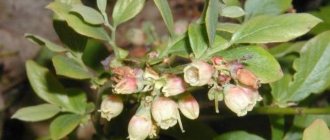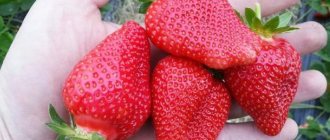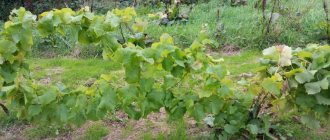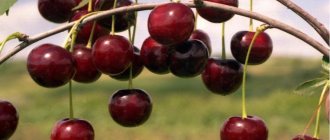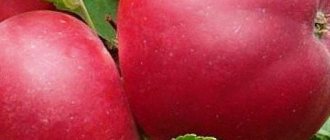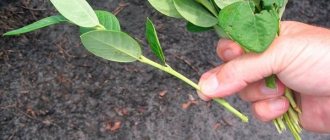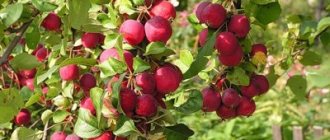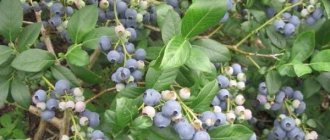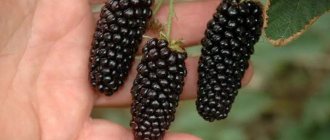Photo and description of the cherry variety Bull's Heart
This is a large-fruited variety. The weight of the berry is 7-8 g. The appearance of the fruit is somewhat reminiscent of a heart, due to which, among other things, the variety acquired its name. The shape of the berry is round, with slight compression. The shell is dense and smooth.
The color of the cherry is dark burgundy, even close to black. The stalk comes off the fruit easily and does not cause juice to leak out.
Under the shell there is dark red flesh. But its color is not so intense and is far from black. The pulp is dense and contains a large amount of juice.
The berries are delicious. Ripe cherries are very sweet, with a barely noticeable hint of sourness. The berries can be used anywhere, from raw consumption to making jam or jam.
Mature tree height
The tree is growing rapidly. Already 4-5 years after planting the seedling, it may surprise you with a thick crown. After reaching 5 years of age, the growth rate of cherries slows down. A fully mature tree has a height of 3-5 meters.
The crown of the Bull's Heart is of a pyramidal type, the foliage is medium. The leaves themselves are large and dark green in color.
Due to the fact that the tree has relatively low foliage, there are no special requirements for unventilated areas when planting. And it makes harvesting much easier.
Flowering and ripening period
The berries are characterized by gradual ripening. On the one hand, this is a plus, on the other, a minus. Gradual ripening allows for slow harvesting, which is very convenient for home use. On the other hand, if cherries are traded, especially on an industrial scale (wholesale), then this is not entirely convenient.
The first cherries appear in June-July. It is difficult to give specific dates, since everything depends on the growing region and climatic conditions. For example, in the south of our country, ripe cherries can already be eaten at the end of May, beginning of June.
Productivity
This is a high-yielding variety. From one Oxheart tree you can harvest 40 kg of berries. You need to pick the berries carefully, as ripe fruits are plump and easily burst under any pressure.
Transportability
The big disadvantage of Bull's heart is that it cannot be stored for a long time due to its high juiciness. This same juiciness hinders transportation, especially if it is necessary to transport the berry over a long distance.
Drought resistance
The Oxheart variety can easily tolerate droughts, but this means that the crop does not need to be watered. On the contrary, this cherry loves moisture and abundant watering. They are the ones who allow the berries to fill with juice.
Frost resistance
Despite the fact that the cherry was created in a southern country, it has, surprisingly, excellent frost resistance. Bull's heart is resistant to the cold of the middle zone, but only when the crop takes shelter for the winter.
Characteristics of the cherry variety Bull's Heart
Like other varieties of cherries, Bull's Heart shows high growth rates at the beginning of its life, and already at 4–5 years the seedling forms a fairly strong, medium-density crown. Subsequently, annual growth decreases somewhat, and an adult tree with a pyramidal crown, narrower than that of related plants, reaches a height of 3–5 meters. Skeletal branches are characterized by a low degree of branching. The shoots are sparsely covered with foliage, which provides good ventilation of the crown and access deep into the crown for pollen-carrying insects.
Caring for Bull's Eye cherries
The fruit crop has established itself as an undemanding plant. If all the rules were followed during planting, then minimal care will be required. For effective fruiting, the tree requires regular watering, feeding procedures and pruning.
Feeding and watering
During the season, the Bull's Eye variety needs to be watered generously 3-4 times; in dry weather, the number of procedures is doubled. Moistening is effectively carried out together with root feeding. For these purposes, slurry prepared in a ratio of 1:8, an infusion of wood ash in a ratio of 1:10, and complex compositions for fruit and berry crops are used. In the spring, dry urea should be added to the cherries at the rate of 60-80 g of the product per tree.
Weeding and loosening
After watering, it is recommended to loosen the soil so that a crust does not form on the surface of the earth. Weeds are regularly removed. Because pathogenic microorganisms and harmful insects can settle on it, causing dangerous cherry diseases.
Crown formation
Bull's Eye cherries should be pruned in the spring, shortening the skeletal branches and forming them into two tiers. On the first one, 7-9 branches are left, and on the second one, 2-3 branches. To limit the growth of the central conductor, it is necessary to trim it to 3-3.5 m. In addition, in the spring you should do sanitary pruning, getting rid of damaged branches. To avoid infection, it is recommended to treat cut cherry trees with garden varnish. There are more tips on planting and pruning in the video below.
Rules of care
The Ox's heart cherry is extremely picky in care, so in a suitable climate it can be successfully cultivated even by novice gardeners. Let's consider the main features of caring for cherries of this variety.
Watering
The tree requires mandatory watering, especially in dry, hot weather. Note that young plants are watered more often, but less abundantly, and adults - less often (4 times per season), but in a much larger volume.
It is recommended to loosen and mulch the soil around the tree after the watering procedure. This measure will help retain moisture at the roots, saturate the soil with air, and protect from weeds. It is better to make a mulching layer from compost or peat - in this case it will also serve as additional nutrition for the tree.
You should not overfill the tree with water; however, you should not allow the soil to dry out either. It is important to stick to the golden mean and water the tree in such a way that its roots are always in moderately moist soil.
Feeding
Cherry Bull's heart needs proper feeding. You shouldn’t be overzealous with fertilizers: it’s enough to dig up the soil with mullein every few years. In addition, every spring it is recommended to apply a solution of ammonium nitrate to give strength to the cherries and activate their growing season. It is also worth learning more about existing fertilizers, as well as sensor reviews about Tyutchevka cherries.
Trimming
This procedure must be started starting from the second year of the tree’s life. During the first few years, you need to use pruning to form the skeleton of the plant and shape its crown.
Formative pruning should only be done in spring.
In addition, every spring and autumn it is necessary to carry out the so-called sanitary pruning of cherries, removing old and diseased branches, diseased and deformed shoots in the process. But how cherries are treated against aphids, and what products should be used, is described in this article.
In the video - pruning cherries:
Purpose of the variety
Cherry tomatoes are used whole or in halves to decorate meat dishes, salads, and appetizers. Thanks to the sweet dessert taste, the fruits can be used not only in regular vegetable salads, but also in fruit and berry salads.
According to its characteristics, “Bull’s Eye” is ideal for drying. Skillful housewives have adapted to drying tomatoes at home using electric dryers, ovens and convection ovens. In winter, such preparation will give any dish a unique taste and aroma.
Using these small and strong tomatoes, you get not only tasty, but also beautiful preservation. Preparations with cherry tomatoes “on a branch” look especially impressive.
Both adults and children eat Bull's Eye tomatoes in their natural form. Even those children who do not like vegetables enjoy eating them.
It is also profitable to grow this variety for commercial purposes. A long growing season and high yields allow for good profits. In addition, the price for this variety of tomatoes is always an order of magnitude higher, and demand remains at a consistently high level all year round.
Characteristics of the plant and characteristics of the fruits
The variety is indeterminate, plant height in open ground reaches 2 meters, growth in a greenhouse is unlimited. A plant without a formation procedure branches very much. Stepchildren are formed in the axils of the leaves, and peduncles are formed on the shoots outside the axils. The stems of young bushes are soft, light green in color, but as they grow they become lignified and, if not tied up, lie down.
The brush that will produce the first tomatoes is placed above the 7-8 leaf, the second - after 2 leaves. The first two clusters are simple with 10-12 fruits, the subsequent ones are formed after 1-2 leaves and bear 30-40 tomatoes each. The flowers are large; in inflorescences they bloom one after another, which ensures almost simultaneous ripening of tomatoes in one cluster.
The fruits are the same size, round in shape and average weight not exceeding 30 grams. Fully ripe tomatoes are juicy red in color with a smooth glossy surface. The pulp is two-chambered, sweet and juicy. The peel is very delicate and soft. The fruits have a high content of lycopene and sugars (more than 4.5%).
The productivity of the variety is high. In greenhouse conditions it is 10-12 kg per square meter, in open ground 7-8 kg.
Ripening dates and growing regions
The tomato has early ripening periods (90-95 days), and therefore is especially valued in regions with a long spring and late summer. But it is successfully cultivated throughout Russia. The variety is characterized by a long fruiting period, so it is more advisable to grow it in closed ground conditions. In glass and film greenhouses in mid-latitudes, “Bull’s Eye” will produce crops until frost, and in greenhouses with heating and lighting, the growing season can last more than one year. In regions with long and warm summers, the tomato will have time to produce a good share of the harvest in open ground.
Advantages and disadvantages
Let's find out what strengths and weaknesses this fruit variety has.
pros
- Outstanding taste and large berry size.
- The variety is frost-resistant. Despite its southern origin, the Bull's Heart also tolerates frosts in the middle zone well: of course, if the tree is under cover.
- The Ox Heart variety is resistant to the most common cherry disease, coccomycosis.
- The variety is characterized by high productivity.
Minuses
The main disadvantage of the variety is its low transportability, keeping quality and extremely short fresh shelf life because of this.
The berries crack very quickly, so harvesting is fraught with some difficulties. Fruits can burst due to mechanical damage, temperature changes, active sunlight, and also in some other cases.
This article will help you understand what pollinators exist for the Bryansk pink cherry and what it looks like.
But what is the height of the Revna cherry tree, and how many fruits can be collected from the tree, is indicated here.
It will also be interesting to see what columnar yellow cherries look like: //gidfermer.com/sadovodstvo/yagody/kolonovidnye-chereshni-sorta.html
You may also be interested in learning about the Iput cherry variety, and for this you should read the description.
Photo and description of ox heart cherries
The variety got its name due to the unusually large size of the fruits. The Bull's Heart cherry is the result of the fruitful work of Georgian breeders. Intended for cultivation on the territory of Azerbaijan and Georgia, can be cultivated in the southern regions of Russia. Some gardeners call the culture differently - Oxheart. You can clearly see the size of the fruit in the video below.
Mature tree height
A variety of medium vigor with a height of 3 to 5 meters. The pyramid-shaped crown does not require intensive annual pruning. The cherry tree has an average number of branches that grow few leaves. The fruits are formed on bouquet branches.
The development of young shoots in the Bull's heart is quite active. The branches are erect and covered with brown bark. The buds of this variety are ovoid, the leaves are quite large with a dark green surface. The inflorescences are large, consisting of 2-3 flowers with white petals. The calyx is goblet-shaped, the sparse petals do not touch each other.
Flowering and ripening period
The flowering of the crop begins in mid-May and lasts approximately 7-10 days. Ox heart is considered a self-sterile variety, therefore, for better formation of the ovary, other pollinators are needed next to the crop. The harvest ripens at the end of June.
Productivity
This cherry variety has consistently high yields. In the presence of favorable weather conditions, an adult crop produces 40 kilograms of berries. The fruits are juicy, their skin begins to burst at the slightest pressure, so harvesting must be done with special care.
The fruits have an attractive appearance. The pulp contains juice, a large amount of vitamins and microelements. The seed is cream colored. Short stalks hold the berries on the branches. If they are not collected on time, the fruits may hang on the branches for another month until they dry out. A feature of the variety is the easy separation of the drupes and pulp from the stalk. Tasters gave the Bull's Heart cherry a taste score of 4.9.
Transportability
The fruits are unsuitable for transportation over long distances due to the insufficient thickness of the skin and the saturation of the fruit with liquid. At the slightest pressure the fruit bursts. The berries are suitable for fresh consumption; in addition, they are used for preservation for the winter.
Selection of seedlings
The tree is unpretentious; to maintain a good level of fruiting, you need to take into account several nuances and observe them throughout the entire period of cherry growth. When purchasing a seedling, special attention is paid to the condition of the root system. There should be no damage to it. The roots of a healthy tree are massive and large.
It is recommended to make a purchase in local stores or nurseries - in them the tree is prepared for the weather conditions of the region.
Pollinators ensure a good harvest. To do this, you need to take care of purchasing several cherries at once and planting them at a short distance from each other. You can buy different varieties, taking into account the requirement that they bloom simultaneously.
Main landing rules
To plant cherries you will need a hole with a depth of 0.7-0.8 m and a diameter of about a meter. It is advisable to place a mixture of humus and chernozem at the bottom. If the soil is saturated with sand, line the bottom with a layer of clay so that the nutrients are not washed out in the first month after planting. A 10-15 cm layer of clay will do an excellent job of drainage. But if the soil is clayey, add sand.
preparing a hole for planting
Before planting begins, the lower part of the tree is soaked in water. If desired, you can add any root growth regulator to the water (Heteroauxin, Kornevin, etc.). This is done so that the roots are saturated with moisture in the required volume and better tolerate planting. To protect a young tree from the wind, drive a stable peg into the hole and tie the trunk to it; it will become a reliable support for the not yet strong seedling.
The roots in the hole must be carefully straightened and covered with prepared soil mixture. Do not compact the soil; at first, the root receives the necessary oxygen through it. The root collar needs to be raised; as it settles, it will take the correct position in relation to the ground level, rising 5-6 centimeters above it. Be sure to water the tree well after planting, using 2-3 buckets of water per plant.
After planting, the branches should be trimmed to a quarter of their length. Thanks to pruning, the tree's resources will be devoted to the development of the root system, in addition, this will allow the formation of the correct crown to begin. The correct crown shape is the key to a successful harvest.
How to plant ox heart cherries
It is advisable to plant cherries on fertile lands in sunny places. To prevent freezing, the crop is placed under the protection of a fence or hedge.
How to choose a seedling
When purchasing a plant for planting in the garden, pay special attention to its root system. It is desirable that this part consist of branched springy processes. It is also necessary to inspect the cherries for damage and disease.
Planting dates and scheme
According to experienced gardeners, young seedlings are best planted in the spring before the juices begin to flow. In this case, the cherry tree will take root and acclimatize. Planting the Bull's Heart can also be done in the fall. Work begins approximately three weeks before the first frost appears. To prevent freezing of the bark and root system, young trees planted in the fall are covered with spruce branches. When grown in the shade of other fruit trees, the berries will be unsweetened. Bull's heart is a low variety of sweet cherry. It is best to plant it on the south side of slopes, in places with loose soil.
Sandy clay or peat soil is absolutely unsuitable for planting cherries. Here the plant will not take root or will produce a poor harvest. And one more nuance that should be taken into account is the groundwater level. It should be no higher than 1.5 meters relative to ground level. Otherwise, the roots of the plant will begin to rot due to excess moisture. The Bull's Heart cherry is placed according to a 3×3 or 3.5×3.5 meter pattern. Only in this case will the trees be provided with a sufficient amount of heat, moisture and nutrients.
Pit preparation
Work on preparing the hole begins 15-20 days before the expected planting date:
- The dimensions of the pit are 60-80 centimeters - length and width, 60 centimeters depth;
- Drainage, large stones, pieces of unnecessary brick or slate are placed at the bottom of the recess. For subsequent gartering of the plant, a support, a wooden stake, is dug in.
- 15 kg of organic matter (humus or compost) is mixed with the top layer of soil and poured back into the hole.
- The formed mound will be compacted until the seedling is planted.
10 hours before work, the young animals are placed in a bucket of water. The planting process itself consists of several simple operations:
- when burying a crop in a hole, its root collar should be above the soil level, which will prevent the growth of unnecessary shoots from the scion.
- The cherries are lifted, which will allow the free space between the roots to be filled with soil.
- After planting, the soil is compacted and watered.
Plant development is stimulated by pruning. The branches are shortened by a quarter of the length. Thus, the beneficial substances in the Ox Heart cherry will not be directed to the intensive growth of the aerial part, but to the formation of the rhizome.
How to plant
Let's find out the main points of planting the Bull's Heart cherry.
Place
Choose a sunny area for this tree, saturated with warmth and light. It is better not to plant Bull's Heart in the shade: the taste of the berries will not be sweet enough. In addition, it is absolutely not suitable for growing cherries in swampy soil, as well as in lowlands where water often accumulates.
Selection of seedlings
In general, the plant takes root easily, however, when purchasing, in any case, you need to pay attention to its general condition. It is important that the seedling has no external damage, is not sick or deformed. It is recommended to purchase planting material from good nurseries: in this case, there is a guarantee that the seedling will grow into a strong and productive tree and will not be sick or infected. Information and photos will help you understand where to plant Fatezh cherries.
In the video - planting cherries:
It is very important that the seedling has a vaccination mark.
Timing
For autumn planting, choose a time when there are about 2-3 weeks left before a major cold snap. At the same time, it is important to thoroughly loosen and fertilize the soil so that the young plant can safely survive the winter.
Advantages and disadvantages of cherries Bull's heart
Among the cherry varieties grown in Russia, there are no completely self-fertile varieties.
Without pollinators growing nearby, the Bull's Heart cherry does not bear fruit to its full potential, forming only 5–10% of the possible ovary. Compared to similar large-fruited, but southern varieties, the Bull's Heart cherry is quite well adapted to harsh winters. It enters spring without serious damage after frosts of about -25 °C. Perennial wood is not affected, but flower buds may die. This also happens during spring frosts, but the next year the trees make up for the loss and are ready to show themselves in the best light.
To simplify the care of the Ox Heart cherry, choose a sunny place for planting, protected from autumn and winter winds. Pollinator varieties that bloom at approximately the same time must be planted in the neighborhood.
Large-fruited varieties are often susceptible to cracking. Bull's heart is no exception. Usually the skin cannot stand it and bursts when pouring occurs during a wet period. To prevent ripening fruits from being spoiled in favorable weather, it is worth limiting watering the trees.
In most cases, plantings successfully resist infection by harmful fungi, but prevention will not be superfluous. Spraying is carried out in the early vein before flowering and in the fall, when the trunk circles are cleaned and sanitary pruning is carried out.
Cherry ripening Bull's heart - video
The highest yielding varieties in alphabetical order
For you, the main thing is high yield and solid profit from one tree? Then this category of trees is right for you. From 1 hectare you can harvest up to 15-30 tons, despite the fact that record yields are collected in Iran (55 t/ha). The following varieties yield up to 50-60 kg per tree, making them the best options for subsequent sale of products to the market or to wholesale outlets.
- Cherry Ovstuzhenka. An unusual fruit from the point of view of many gardeners is the black cherry, and its shape is cone-shaped. One of its main advantages is high yield - up to 115 centners on average and 250 maximum. With good care and abundant watering, it can easily produce up to 50 kg from one tree, and this is far from the limit. The sugar content is 11%, which also makes it one of the sweetest and most delicious in the Russian Federation and other neighboring countries. The crown is spreading, wide, the branches bend down under the weight of the fruit, in some cases supports are required, since in high winds they break off - this is perhaps the only disadvantage of this variety. Frost resistance is average - can withstand up to -25 degrees throughout the winter.
- Cherry variety Revna. Very recognizable in Russia, it has a light skin and dense flesh. Due to its yield of up to 30 t/ha, it has become one of the best options for domestic farmers. Revna cherries, reviews of which you can hear from every gardener, tolerate frost well, even at -5 degrees in April the color does not fall off, therefore it is recommended for cultivation in colder regions than the temperate climate zone. The crown is spreading, the tree grows tall, so it is recommended to pinch the top to form a suitable option for industrial use. By growing the Revna variety, you will always have cherries, even in the leanest year, since the stability of fruiting is greater than that of other varieties.
- Cherry Fatezh. Quite an interesting specimen, which was bred quite recently. Annual seedlings grow straight up, forming a peak-shaped crown, after which for the next 4-5 years they bend down and hang down to the ground, thereby significantly increasing the convenience of harvesting. It produces up to 60 kg from a 10-year-old tree, for which it has received very high marks from many gardeners who grow it. High winter hardiness and indifference to sudden temperature changes in the spring made it number 1 among high-yielding options. It should only be grown close to other trees for high-quality pollination. Early cherries ripen at the beginning of June or even at the end of May, depending on the temperature of the year.
Varieties of foreign selection are not recommended to be grown in our temperate latitude. They require increased attention, are sensitive to droughts and do not tolerate frosts well. It is best to give preference to Russian selection, since the plants are maximally acclimatized to our growing conditions and maximally resistant to insect pests.
Late varieties
Late varieties are very appropriate: by the time many of the fruits are gone, they begin to bear fruit. Most often, the berries ripen towards the end of summer.
Late types include:
- Bryansk pink;
- Regina;
- Cordia;
- Melitopol black;
- Daibera.
Bryansk pink cherry . The trees grow to small, compact sizes. The fruits are sweet with juicy dense pulp. They tolerate transportation well and rarely crack. The plant is resistant to fungal diseases and winter cold.
Cherry Regina . Also a low grade. It has large dark garnet-colored berries that can easily withstand transportation and long-term storage. They do not crack during rains. Another great advantage is that after ripening the berries do not fall off for a long time. The productivity is quite high. The tree is resistant to severe frosts.
Cherry Cordia . One of the varieties of dwarf cherries. Ideal for production for sale. It has high transpontability, the berries rarely rot or crack. The plant produces high regular yields. After ripening, the fruits do not fall off for a long time, which makes harvesting easier.
Melitopol black cherry . Grows to medium size. It has juicy, aromatic berries with dense pulp. The fruits are used for sale both fresh and processed. Excellent for preservation. Very good yield. Tolerates frost normally.
Daibera cherry . One of the most ancient varieties. Has a very high yield. The fruits are large, juicy with a pleasant sourness. The berries are suitable for any processing. But the plant has a significant disadvantage, namely: poor resistance to disease.
Cherry is a wonderful plant that will always delight you with sweet, juicy berries. Select and arrange different varieties so that the flowers are well pollinated. This will help you get a high yield. Do not forget about proper care, feeding and prevention against diseases. Then your table will always be rich in these wonderful fruits. Also read our article “How to prune cherries correctly.”
Opinions of amateur gardeners
Reviews from people who grow Ox Heart:
Natalya, Rostov-on-Don:
“We’ve been growing Bull’s Heart cherries on our property for a long time; we have several trees of this variety. I really like the variety for its large fruits, very tasty and juicy. Of course, the berries don’t last long, but they can be sold quite successfully at the local market: the entire volume is quickly taken away. As for care, it is standard: it is only important to water and prune the tree, and, of course, protect the berries from birds. I recommend this variety: it is the largest-fruited domestic variety and, in my opinion, the most delicious.”
Source:gidfermer.com
Pavel, Voronezh:
“I have a large garden: I grow fruit crops for sale. There are also several varieties of cherries: Bull's Heart among them are three trees. I like this variety for its high yields and very large berries. I’m one of the first to sell it: the berries are very beautiful and impressive, but they don’t last long, so it’s important to sell them right away, or only make preparations later. Maintenance is simple: fertilizing, watering, pruning - everything is standard. It is better to cover it for the winter, since the tree does not tolerate low temperatures.”
Source:gidfermer.com
Reviews
Let's find out what opinions gardeners in our country share about growing cherries.
- Natalya, Rostov-on-Don: “We’ve been growing Bull’s Heart cherries on our property for a long time; we have several trees of this variety. I really like the variety for its large fruits, very tasty and juicy. Of course, the berries don’t last long, but they can be sold quite successfully at the local market: the entire volume is quickly taken away. As for care, it is standard: it is only important to water and prune the tree, and, of course, protect the berries from birds. I recommend this variety: it is the largest-fruited domestic variety and, in my opinion, the most delicious.”
- Pavel, Voronezh: “I have a large garden: I grow fruit crops for sale. There are also several varieties of cherries: Bull's Heart among them are three trees. I like this variety for its high yields and very large berries. I’m one of the first to sell it: the berries are very beautiful and impressive, but they don’t last long, so it’s important to sell them right away, or only make preparations later. Maintenance is simple: fertilizing, watering, pruning - everything is standard. It is better to cover it for the winter, since the tree does not tolerate low temperatures.”
And here you can read reviews about Black Prince cherries.
We looked at the features of cultivating such a variety of cherries as Bull's Heart. As you can see, despite the amazing yield and large size of the fruits, the variety also has its drawbacks in the form of low keeping quality and the tendency of the berries to crack. Therefore, it is better to grow Ox Heart for personal use, and if for sale, then only on the local market: the delicate fruits will not tolerate long-term transportation.
Large-fruited cherry variety Bull's Heart for summer residents in central Russia
Every year, cherries gain more and more fans among gardeners not only in the south, but also in central Russia.
Everyone wants to get sweet, full-bodied fruits, such as, for example, the Bull's Heart cherry, which is considered the largest-fruited variety obtained by domestic breeders. The culture received its name due to the rich dark red hue of the fruits and their external resemblance to the heart of a large, powerful animal.
Important agricultural practices:
Forming and tying a bush
Forming and tying the Bull's Eye variety are mandatory and important procedures. Without completing them, the bushes will quickly gain green mass and turn into impenetrable thickets, crawling along the ground or reaching up to the ceiling of the greenhouse. The harvest in this case will be minimal.
Bushes are formed into one or two stems. The remaining shoots are regularly and carefully removed, leaving a stump of 1-2 cm. In addition, the leaves under the clusters that have begun to sing are periodically removed. The thin liana-like stem is tied up 2 weeks after planting. In open ground conditions and film greenhouses, a month before the onset of cool weather, the top of the stem is pinched. This will give all the tomatoes the opportunity to fully form and ripen.
Watering, loosening, mulching
The technique for watering cherry tomatoes differs from conventional ones. Plants of this subspecies do not tolerate drought and do not tolerate excess moisture well. Therefore, they should be watered once every 2-3 days, but not too much. The water should be settled and warm. To prevent crust from forming after watering, the soil around the plants is mulched or regularly loosened.
The mulch layer can be made of natural or artificial materials.
As natural or organic mulch, it is good to use straw, young weeds without seeds, sawdust, compost, and newspapers. Straw and newspapers are laid in a layer of 15-20 cm, young grass in a layer of 5 cm, compost in 3 cm. Gradually decomposing, these materials turn into humus and additionally fertilize the soil.
Artificial material, as a rule, is laid on the beds even before the tomatoes are planted. Then, in accordance with the planting scheme, cross-shaped cuts are made into which the plants are planted. In open ground, you can use black film or spunbond. It is not recommended to use film in a greenhouse; this can lead to overheating of the soil.
Feeding
Tomatoes are fed once every two weeks, starting 10-15 days after transplantation. For fertilizing, you can use commercially available complex fertilizers or resort to folk recipes. A good option would be to alternate these methods. It is important to remember that the plant requires nitrogen for active growth, potassium for the formation of stems and flowering, phosphorus for the development of the root system and fruit ripening.
Prevention from diseases and pests
Treating tomato diseases is very difficult, and sometimes impossible. It is much easier to follow these simple rules of content:
- disinfect the soil before planting;
- water the plants only at the roots, and not by sprinkling;
- avoid high humidity in shelters;
- do not plant other crops in the greenhouse;
- avoid crowding of plants (follow the planting pattern, pluck off shoots and leaves);
- immediately remove plants with signs of fungal diseases from the garden;
- regularly carry out preventive treatment against diseases and pests, alternating folk remedies with professional ones.
Agricultural technology
When choosing seedlings, you need to look at the roots and make sure there are no external defects. The roots should be separated and massive.
It is better to plant young trees in the spring, then they will have enough warm days to get used to the new place. The tree can be planted in the fall, but this must be done several weeks before the first frost. Before this, you should carefully dig and water the soil. You definitely need to take care of shelter for the tree so that it can survive the first winter.
The distance between cherries should not exceed 3-3.5 m.
Cherry garden
Landing
If, on the eve of planting, dried areas of the root system were noticed on the seedling, the roots should be immersed in water overnight.
Landing rules:
- You cannot bury the root collar in the ground to prevent the growth of wild shoots that will interfere with the development of the plant.
- During planting, you need to shake the seedling a little. This way the soil will sufficiently fill the inter-root area.
- After planting, you need to tamp down the soil and water it well.
- It is advisable to trim the branches by a quarter. This way the root system will grow effectively and the correct crown will be formed in the future.
Care
Oxheart is a fairly unpretentious tree, but still needs some care.
Cherries love moisture. You should not water too often, as the berries may crack. The soil is moistened approximately once a month, but weather conditions must be taken into account. Young cherries will need up to 3 buckets of water. An adult fruit-bearing tree will need up to 6 buckets.
Watering a tree
When planted, the seedling receives nutrients that will be sufficient for the first 2 years. Next you need to fertilize with ammonium nitrate. Sometimes diluted manure is chosen for fertilizing; such fertilizer should be applied no more than once every 2-3 years. In the autumn, organic additives are used.
Caring for cherry ox heart
The cherry variety in question does not require special care, but some rules must still be followed. Below are the basics of agricultural technology.
Feeding and watering
Any variety of cherries needs a sufficient amount of moisture and sunlight, but watering the Ox's Heart must be done with care, because stagnation of moisture in the root zone will stimulate cracking of the skin of the berries. The soil is moistened according to weather conditions, but at least once a month. At the same time, 30 liters of water are used for each young tree; for adult crops, the amount of irrigation liquid is increased.
To prevent the formation of a dense crust, the soil is loosened after watering, and then peat or compost mulch is laid. These materials will retain moisture and prevent the development of weeds.
The nutrients that are put into the soil during planting will be enough for the tree to last for the next 3 years. Upon reaching 3 years of age, the plant is fed with nitrogen fertilizer at the rate of 120 grams of urea per 1 m2 of plot. Mature cherry trees Bull's Heart are watered with mullein solution in a ratio of 1:10 to water.
Crown formation
The process of crown formation begins in a two-year-old tree. First you need to remove weak and disease-damaged shoots. Pruning long, healthy shoots allows you to maintain the desired crown shape. Sanitary pruning of the Bull's heart should be carried out in spring and autumn. Remove dried, deformed and large shoots. Plant wounds are covered with paint or copper sulfate.
Pollinators of cherry ox heart
The variety in question is considered conditionally sterile; in the absence of a pollinator, cherries can form no more than 5% of the potential yield. To increase the number of fruits in combined plantings, Tyutchevka, Iput and Ovstuzhenka are used. The best result is achieved by maintaining a distance between neighboring crops within 4 meters.
Diseases and pests of ox-heart cherries
The variety perfectly resists most diseases and pests, but the crop is not resistant to coccomycosis. The disease affects the leaves and fruits of cherries, and the spores quickly spread throughout the garden. Prevention consists of the following:
- throughout the growing season, shoots, fruits and leaves damaged by the disease are cut off, this is necessary to prevent further spread of the fungus;
- In the spring, before the buds open, treat the Ox heart with a solution of Bordeaux mixture at 3% concentration.
- some time after setting the buds, the plant is sprayed with the chemical preparation “Horus” according to the manufacturer’s instructions.
Pests of this cherry variety are killed with insecticides.
Processing ox-heart cherries in spring
Preventative spraying of this variety of Bull's Heart is carried out in the spring. During the work, the garden is treated with a solution of copper sulfate. Burlap with a metal mesh will help prevent rodent attacks.
Preparing cherry ox heart for winter
When preparing this variety for wintering, abundant watering is necessary, which will prevent a possible lack of moisture. To protect the root system from freezing, compost mulch is used, which is laid in a circle around the trunk.
Disease and pest control
As already noted, the Bull's Heart cherry is resistant to coccomycosis.
With improper agricultural practices or lack of care, it can be affected by the following diseases:
- Clusterosporiasis . The main symptom is holes and spots on the leaves. The disease should be combated with the drugs “Hom” (40 g/10 l), “Ridomil” (20 g/10 l).
- Fruit rot . When infected, the berries rot and beige dots appear on them. Treatment is carried out by spraying before flowering with “Fundazol” (10 g/10 l of water), “Topaz” (2 ml/10 l); after flowering - “Horus” (3 g/10 l). Branches containing diseased fruits should be cut off and destroyed by fire.
- Bacteriosis . Infestation can be identified by watery spots on leaves and berries. To prevent disease, you should promptly fertilize the tree with nitrogen-containing mixtures and follow the watering technique without over-moistening the soil.
Among the pests that can attack a cherry tree:
- Aphid . The insect can be found in May-July. During its attack, the foliage of the trees withers. To get rid of the pest, treatments with garlic infusion, Fufanon (10 ml/10 l), Confidor (1.5 g/10 l), Fitoverm (1.5 ml/10 l) are used.
- Cherry moth . Attacks cherries in May. Damages the kidneys. Treatments on buds with Confidor (1.5 g/10 l), Fitoverm (1.5 ml/10 l) are effective against insects.
- Cherry fly. In May-June it causes enormous damage to berries. The harmful insect is destroyed with the preparations “Aktellik” (2 ml/2 l), “Fufanon” (10 ml/10 l), “Karate” (4 ml/10 l).
Harvest and storage
You should start harvesting the berries when they gain juiciness, become large and dark red. The stalk should still be green. In order not to injure the fruits of the Ox Heart variety, it is better to cut them with scissors, leaving the stalk on them, and carefully place them in the container in which they are planned to be stored or transported.
Plastic boxes are best suited for this. For berries that are immediately processed, the stems may not be left. You won't be able to store the berries for a long time. They can survive in low temperatures for a maximum of 5–7 days.
Berries can be used for universal purposes - eaten fresh, canned, prepared compotes, jam. To preserve healthy fruits for the winter, they can be frozen. Transportability of the fruit is poor, since the skin has a tendency to crack. It can easily be damaged during collection or transportation.
So, the Bull's Heart variety is annually capable of producing a large number of large, appetizing-looking and tasty fruits. Caring for her does not take much time and effort. The fruits of this variety are suitable only for personal use. They are not suitable for sale.
Fruiting and photos of the Bull's Heart cherry
Very large fruits weighing from 7 to 10 grams are the pride of this cherry variety. Very attractive in appearance, they are distinguished by their dark, sometimes almost black skin and red juicy pulp.
Despite the sufficient density, the skin cannot protect ripe fruits from spoilage and crushing, so it is almost impossible to transport or store the cherry harvest.
Smooth fruits with melting pulp without rough gristle and medium-sized creamy seeds are held on dense, short stalks. If not harvested immediately after ripening, they can remain on the branches for about a month. In this case, the loss of quality is insignificant. When harvesting, the drupe is easily separated from the stalk without damage. The stone comes away from the pulp with little effort.
According to the description, the Bull's Heart variety deserves the highest rating on a five-point scale for its taste and can be used both fresh and as a raw material for canning. The content of sugars and acids in the dense, pleasant-tasting pulp may vary. Their ratio and the taste of the fruit depend on the weather and the care that the tree regularly receives.
